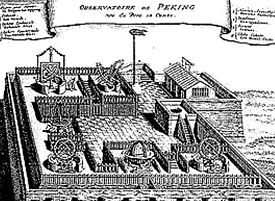August von Hallerstein
August (in) Ferdinand Haller von Hallerstein ( Chinese 劉松齡 / 刘松龄 , Pinyin Liú Sōnglíng ; born August 27, 1703 in Laibach (Carniola) ; † October 29, 1774 in Beijing ) was an Austrian Jesuit and missionary .
Youth and education
Coming from the Nuremberg patrician family Haller von Hallerstein , von Hallerstein first visited the Jesuit college of his hometown Laibach. He then studied in Klagenfurt , Leoben and Graz in addition to theology a . a. Medicine , math and astronomy . In 1721 he joined the Jesuit order in the College of St. Anna in Vienna , where he was ordained a priest in 1734. After leading the Jesuit college in Temesvár for some time , he was sent on a mission.
Activity in China
In April 1736 von Hallerstein embarked in Lisbon and first traveled to Mozambique and Goa . In September 1738 he reached the port of Canton , from where he first went on to Macau . In 1739 he was appointed to the court in Beijing . There he first worked in the Imperial Astronomy Office, which he finally took over in 1746 from his friar Ignaz Kögler .
Hallerstein was considered a world-class scientist. Through various publications in the fields of astronomy, geography and topography, he gained a great reputation. The great national estimate that “198,213,713” people should live in China can also be traced back to his mathematical methods. The Jesuit also had extensive contacts with the Royal Society in London , the Imperial Observatory in Vienna and the Academy of Saint Petersburg . In addition, von Hallerstein was in constant correspondence with his friars all over Europe, but also with the Queen of Portugal , whom he had met when he embarked in Lisbon .
For this reason, Emperor Qianlong entrusted him in 1752 with the care of the Portuguese embassy on their journey from the port in Canton to the Beijing imperial court and back. In recognition of the services he acquired here, von Hallerstein was then elevated to the rank of third-tier mandarin .
In 1744 he constructed an armillary sphere that was considered one of the best of its time. Thereupon he was appointed head of the Imperial Astronomical Office in 1746. He held this office until his death in 1774.
Hallerstein's importance also rose in the church hierarchy: from 1751–1758 he was a visitor , 1757–1762 and 1766–1774 even provincial of the Far Eastern Jesuit mission . Like other leading court Jesuits, von Hallerstein remained largely unaffected by the fight against the Christian missionaries, which was established after Pope Benedict XIV's final ban on accommodation ( rite dispute ) in 1744. Conversely, his influence at the imperial court benefited the persecuted church.
death
Von Hallerstein died of a heart attack in 1774 after the news of the repeal of the Jesuit order by Pope Clemens XIV. Was brought to him - which was also a late consequence of the rite dispute.
Works
- Carte de Macao et ses environs, 1739
- Observationes astronomicae from 1717 ad annum 1752 a PP. Societatis Jesu Pekini Sinarum factae ..., 2 parts, Vienna 1768
literature
- Constantin von Wurzbach : Haller von Hallerstein, Augustin . In: Biographisches Lexikon des Kaiserthums Oesterreich . 7th part. Imperial and Royal Court and State Printing Office, Vienna 1861, pp. 244–246 ( digitized version ).
- Anton Huonder, Dt. Jesuit missionaries of the 17th and 18th centuries 18th century, 1899, p. 66 f. 87, 91, 187 f.
- Louis Pfister, Notes biographiques et bibliographiques sur les Jésuites de l'ancienne mission de Chine II, Shanghai 1934, pp. 753 ff.
- Helmut Freiherr Haller von Hallerstein: Haller von Hallerstein, Augustin. In: New German Biography (NDB). Volume 7, Duncker & Humblot, Berlin 1966, ISBN 3-428-00188-5 , p. 557 ( digitized version ).
Footnotes
- ↑ René Oosterlinck: “Naar Xiwanzi!” À Xiwanzi! Sur les traces des missionnaires CICM . In: Courier Verbiest , vol. 26 (2015), December issue, pp. 10–14, here p. 13.
| personal data | |
|---|---|
| SURNAME | Hallerstein, August von |
| ALTERNATIVE NAMES | Haller von Hallerstein, August Ferdinand (full name) |
| BRIEF DESCRIPTION | Austrian Jesuit and China missionary |
| DATE OF BIRTH | August 27, 1703 |
| PLACE OF BIRTH | Laibach (Carniola) |
| DATE OF DEATH | October 29, 1774 |
| Place of death | Beijing |

